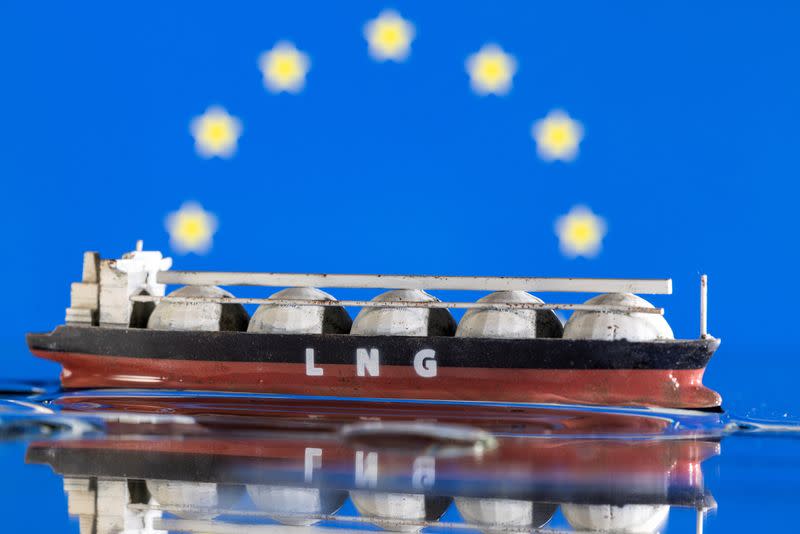Explainer-Slow start? European Union's LNG price plans explained

By Marwa Rashad and Kate Abnett
LONDON (Reuters) - European Union energy regulators published their first daily liquefied natural gas (LNG) price assessment on Thursday, a first step in the EU's plan to launch a new European LNG benchmark price by the end of March.
The idea is that LNG buyers and sellers could use the new benchmark as the basis for their contracts. LNG prices in Europe have historically been pegged to the Dutch Title Transfer Facility (TTF) gas hub price, a centre of high volatility after Russia slashed pipeline gas deliveries to Europe last year.
The EU Agency for the Cooperation of Energy Regulators' (ACER) first LNG price assessment arrived later than its planned Jan. 13 launch, because of an initial lack of data from market participants. Some market players question whether the new price is needed at all.
WHY DOES THE EU WANT A NEW LNG PRICE?
Europe's gas prices raced to record highs last year as Russia curtailed supplies and caused a squeeze that saw EU countries raise their LNG imports by 71% from the previous year, according to Refinitiv Eikon data.
Unlike pipeline gas, LNG is not widely traded on exchanges, so there is less visibility on how much the fuel costs.
The EU tasked ACER with publishing a daily LNG price assessment from Jan 13, aimed at making pricing more transparent, helping to avoid EU countries bidding against each other for supply, potentially driving prices up further.
HOW ARE LNG PRICES CURRENTLY CALCULATED?
LNG cargoes are delivered on an ex-ship (DES) basis, which means the price includes delivery to a specific port, arriving in several European regions. Deliveries into Northwest Europe (NWE) include the United Kingdom, the Netherlands, Belgium and Atlantic France, while Southwest Europe deliveries reach Spain, Portugal and Italy among others.
While European LNG trades have historically been pegged to the TTF gas hub price, energy pricing agencies including Platts, Argus and Spark Commodities, have been using the LNG NWE DES index which better reflects the price of LNG cargoes delivered into Northwest Europe than the TTF.
HOW WILL ACER'S LNG PRICE BE DIFFERENT?
ACER's daily LNG price assessment is based on transactions, which market participants are required to report to ACER, for spot trades involving vessels with a capacity of at least 75,000 cubic metres of LNG.
The assessment would cover trades for delivery in the second half of the month ahead, on a DES basis and will be a weighted average price of daily LNG spot transactions with a rolling window of up to five working days.
A major difference is that other pricing agencies generally aggregate and report data from a single day of the price assessment.
WHY WAS ACER LATE TO PUBLISH A PRICE?
LNG market participants are legally required to report data on their trades. ACER can only produce a price assessment if it receives at least five transactions in the assessed five-day period.
Thursday was the first time it reached this threshold. Before then, most of the data shared with ACER has been unusable - for including that it covered cargoes traded under long-term contracts, or with delivery times too far in the future.
ACER said this slow start was not surprising in the first few weeks of the price assessment, because the European market for LNG spot trades is illiquid, and market participants were still getting used to the new reporting requirements.
MARKET REACTION?
Some industry sources said it would take more time for the EU LNG price to develop, and that current market conditions may have not been in ACER's favour.
"Unfortunately for ACER, the price assessment has started during a period where prices have fallen substantially from previously abnormal highs," said Ryan Pereira, a global LNG industry expert.
Pereira added that the Japan Korea Marker, now widely used as an Asian LNG benchmark, was first established in 2009 and took over 8 years before it was broadly accepted.
Some other industry and trading sources have questioned whether the new pricing index is needed - and whether market participants and banks will actually use it - because many pricing agencies already use the LNG DES index.
"The EU should focus on getting more companies to sign long term LNG offtake agreements rather than just throwing a lot of symbolic red tape on businesses," said Oystein Kalleklev, chief executive of ship-owner FLEX LNG.
(Reporting by Marwa Rashad in London and Kate Abnett in Brussels; Editing by Nina Chestney, Emelia Sithole-Matarise and Bernadette Baum)

 Yahoo Finance
Yahoo Finance 